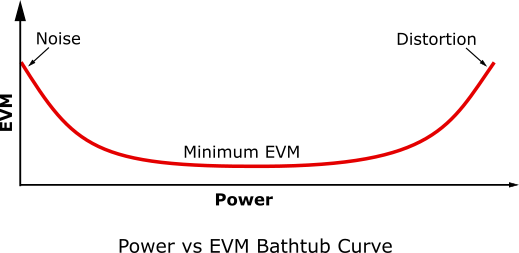About EVM Measurements on PNA and ENA
The manifestation of EVM Error vector magnitude (EVM): A quality metric in digital communication systems. See the EVM metric in the Error Summary Table topic in each demodulator for more information on how EVM is calculated for that modulation format. can come from many different sources. For a demod that has been properly set up, EVM is typically a combination of noise and distortion. At lower power levels, noise tends to dominate, and the EVM increases as we lower power. At high power levels, distortion tends to dominate, and we observe increased EVM as we increase power levels. In the middle, we often see the minimum EVM and so the overall shape resembles a bathtub curve.

In the PNA, the "Modulation Distortion" application (MOD) uniquely uses vector averaging and digital image rejection to reduce the effects of noise. This does not exist on X-series analyzers or oscilloscopes. Therefore, when we compare EVM measurements between a UXA and a PNA, the PNA EVM may be lower because the noise component of the EVM has been reduced. So EVM measurements with a PNA may be more accurately described as "EVM due to distortion." With the PNA, we have an option to analytically add back the noise based on measured noise figure of the DUT Device under Test: An acronym used to describe some type of electrical apparatus connected to test instrumentation. The apparatus can range from a single component to a complex subsystem such as a mobile phone, base station or MSC..
Since the PNA is often used in component test applications, like in measuring amplifiers, it can measure both "single-ended" EVM similar to a spectrum analyzer and the delta EVM across a 2-port device under test. One may check which is being measured by noting the PNA parameter (or measurement) name on the PNA.
- EVMOutEq2 = the single-ended EVM exiting port 2 of the DUT after equalization of the VSA span.
- EVMDistEq21 = The delta EVM from port 1 to port 2 of the DUT after equalization of the VSA span.
- EVMOutUn2 = the single-ended EVM exiting port 2 of the DUT without equalization.
- EVMDistUn21 = The delta EVM from port 1 to port 2 of the DUT without equalization.
Equalized EVM will in general be lower than the EVM without equalization.
Between single-ended EVM and delta EVM, when should we use delta EVM (aka Distortion EVM)?
If the source has nonlinear distortion, then this distortion appears at the input and output of the DUT. The delta EVM algorithm will remove the source distortion errors from the measurement of EVM (alongside the source and receiver noise). In this way, the source does not need to have perfect distortion performance to isolate the additive distortion effects of the DUT. When we compare delta EVM measurements between a UXA and PNA, the PNA delta EVM will often appear lower because source distortion has been removed.
See Also
About PNA and ENA Vector Network Analyzers
PNA and ENA Measurement Parameters
Available Measurement Hardware
